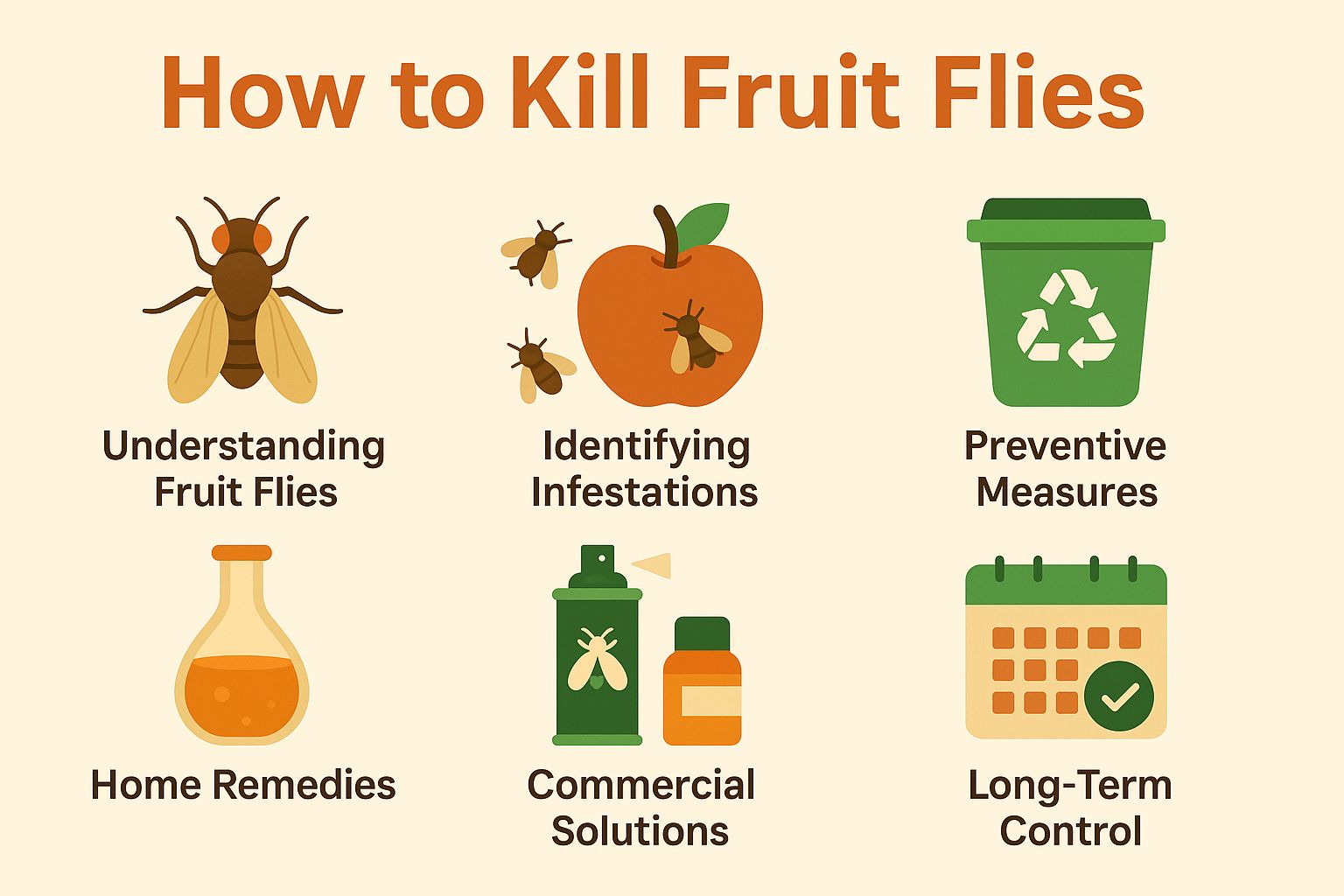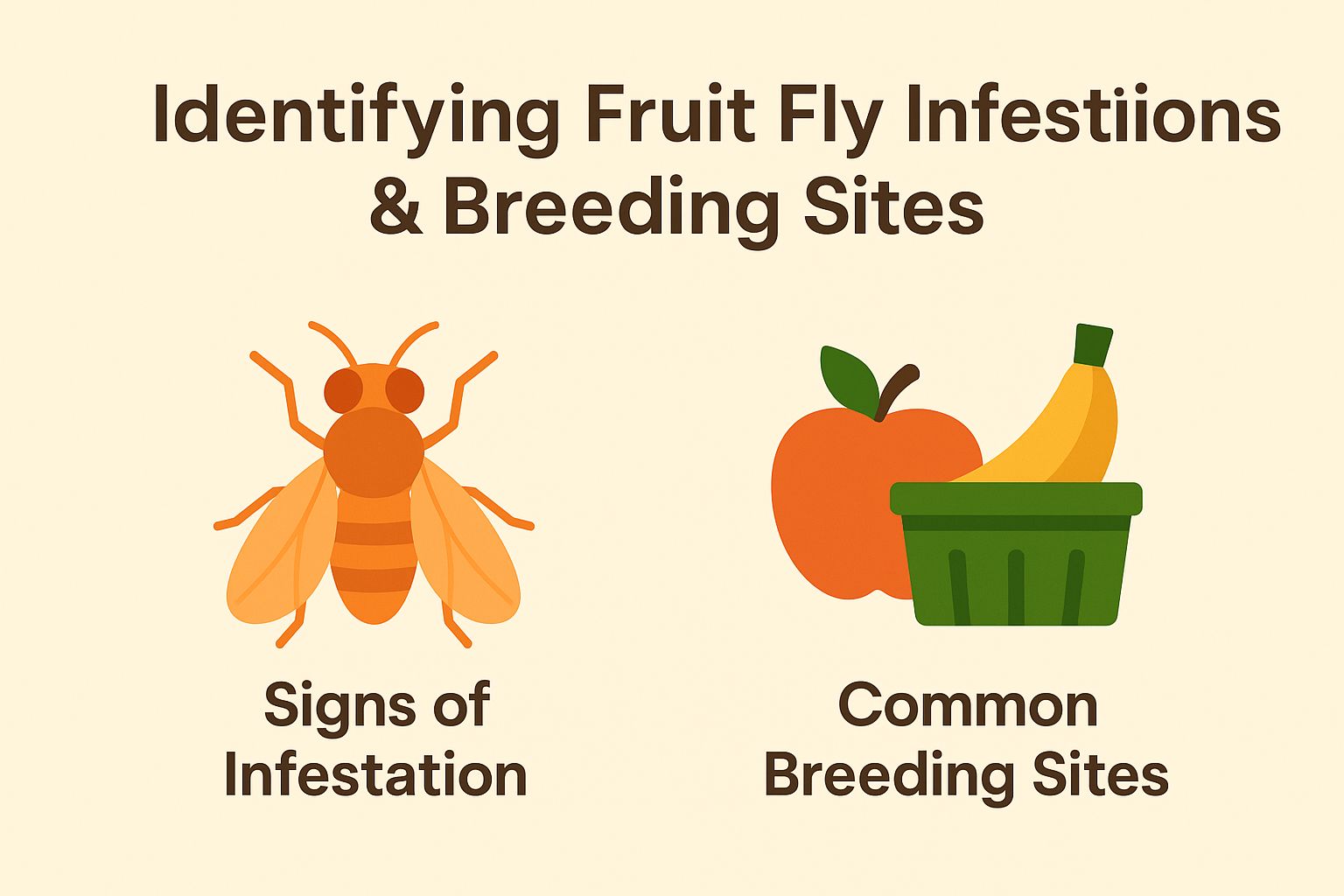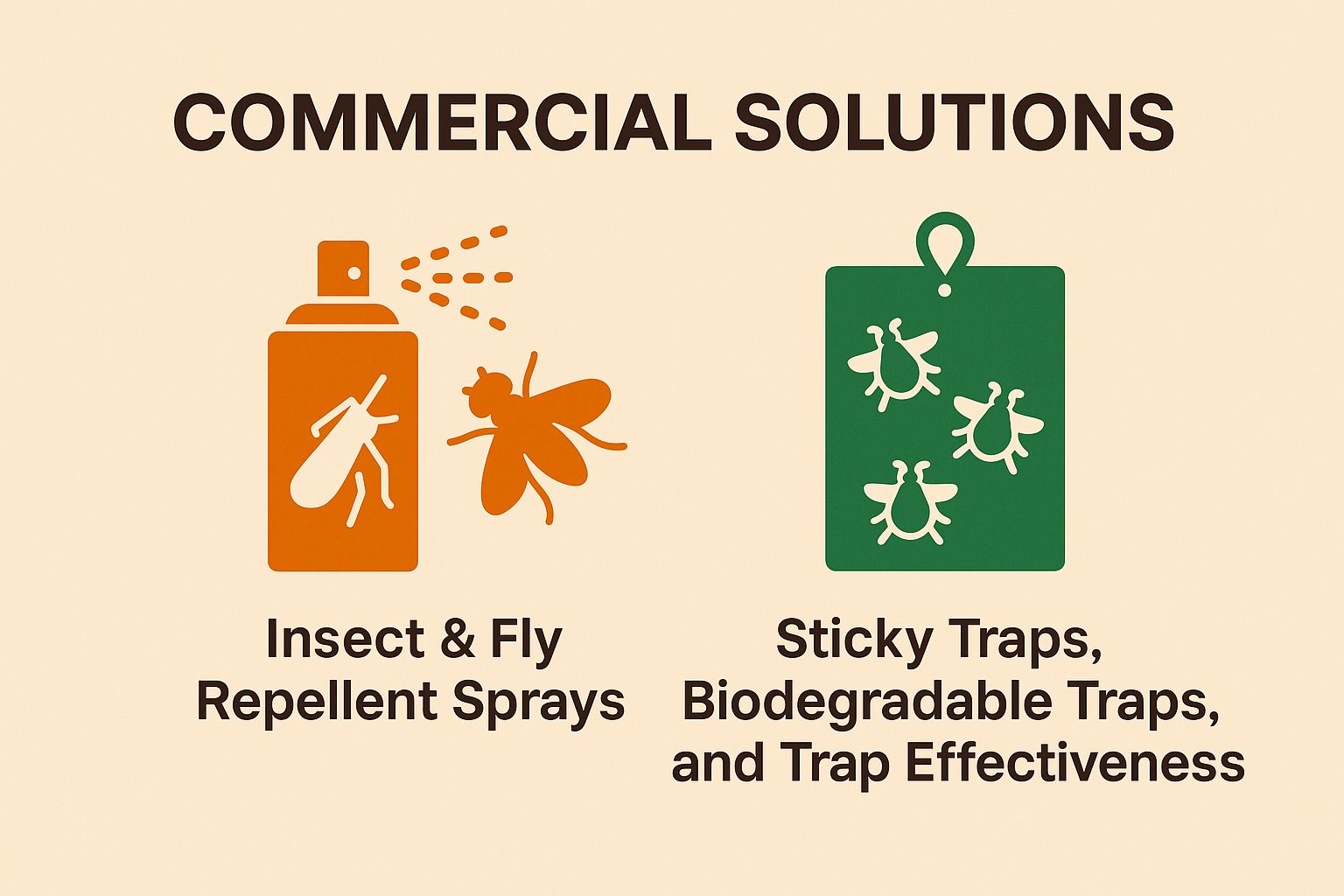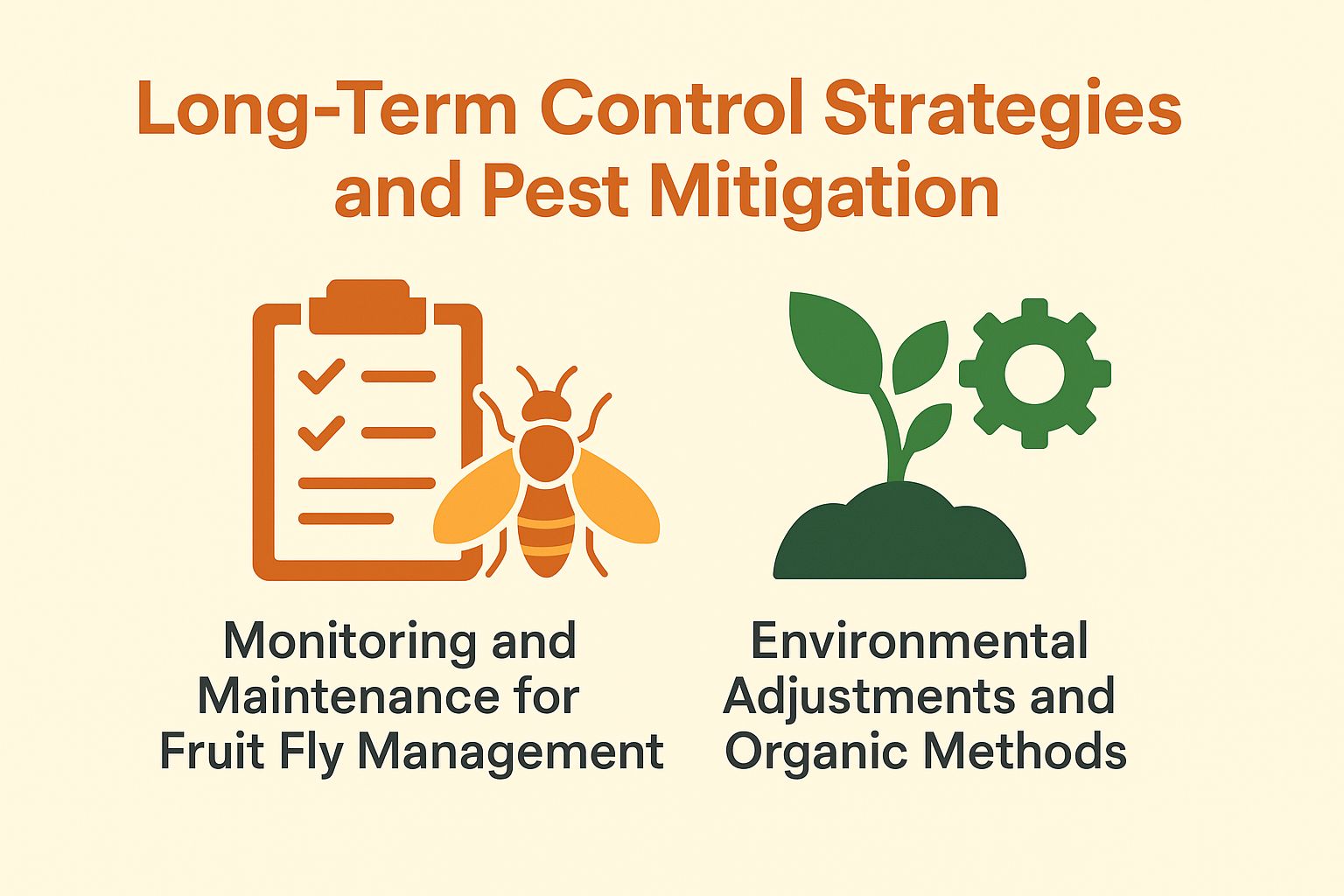
How To Kill Fruit Flies
Are fruit flies invading your kitchen? You’re not alone. These tiny pests can invade your space quickly, turning your home into a breeding ground for annoyance. Learning about their biology and habits is important to taking back your kitchen. From identifying signs of infestation to exploring effective home remedies and commercial solutions, you’ll learn practical steps to eliminate fruit flies for good. Ready to take back control? Let’s dive in!
Learning About Fruit Flies and How They Act
Knowing how fruit flies live and act is essential for controlling them, as they can breed quickly and become a major problem. If you’re interested in a broader understanding of various pests, our insights on 10 common household pests and how to identify them provide valuable knowledge for effective pest management.

Biology and Behavior
Fruit flies, typically measuring 1/8 inch, are attracted to ripe or decaying fruit, and their behavior is influenced by pheromones that help locate breeding sites.
These tiny insects exhibit strong feeding patterns around overripe bananas or rotting apples, where they lay eggs in the fermenting material.
Observations show that males use pheromones to attract females during mating, creating swarms near the food source.
To reduce fruit flies in your kitchen, keep fruit in closed containers and throw away any spoiled items quickly.
Traps can be effective; put apple cider vinegar in a jar, cover it with plastic wrap, and it will attract and catch them, stopping their breeding cycle.
Life Cycle of Fruit Flies
The average life cycle of a fruit fly spans about 8-10 days under optimal conditions, encompassing four stages: egg, larvae, pupa, and adult.
During this life cycle, each stage has distinct environmental requirements and durations.
For instance, eggs take about 24 hours to hatch into larvae, which then feed and grow for approximately 4-6 days before entering the pupal stage. In this phase, lasting about 3-4 days, the larvae undergo metamorphosis. Improving conditions-such as keeping the temperature around 25 degreesC, maintaining proper humidity, and ensuring cleanliness-can speed up growth.
For people interested in insects or scientists, equipment like growth chambers and tracking software can improve breeding success by keeping the right conditions steady.
Identifying Fruit Fly Infestations and Pest Identification
Identifying fruit fly infestations is key to applying successful pest control methods and stopping them from happening again. This includes learning how to identify pests to correctly evaluate the situation. For an extensive analysis of this topic, our comprehensive guide on common household pests provides detailed identification techniques.

Signs of Infestation
Common signs of a fruit fly infestation include spotting the tiny flies around overripe fruit, seeing larvae in food, and detecting a vinegar-like smell.
To combat a fruit fly infestation, take immediate action by disposing of overripe or rotting fruit.
Use a mixture of apple cider vinegar and dish soap in a bowl as an effective trap; the vinegar attracts the flies while the soap breaks the surface tension, trapping them.
Regularly clean areas where food is prepared, especially near standing water or spills, to eliminate breeding sites and follow proper sanitation practices.
Think about closing gaps and keeping food in sealed containers to stop any more invasions.

Common Breeding Grounds and Breeding Sites
Fruit flies thrive in breeding grounds often found in kitchens, particularly in areas with accessible food waste and decaying organic matter.
Common breeding sites include:
- garbage disposals
- compost bins
- overripe fruit left out on countertops
- moist dishcloths
- recycling bins with residue
Cleaning these areas regularly is important. For example, clear out the garbage disposal once a week and rinse it with water and vinegar. Also, store fruits in the refrigerator and regularly check compost bins for excess moisture.
Keeping these areas clean can greatly decrease the number of fruit flies and improve the cleanliness of your kitchen.
Preventive Measures and Pest Prevention Strategies
Keeping fruit flies away starts with clean habits and storing food the right way. It’s also important to be aware of other potential pests that can invade your home. Related insight: 10 Common Household Pests and How to Identify Them

Cleaning and Sanitation Practices
Regular cleaning protocols are essential, as they reduce food sources for fruit flies, particularly in kitchens and dining areas.
To effectively manage fruit fly infestations, establish a cleaning schedule with specific tasks.
Begin daily by wiping down surfaces, removing any spills or crumbs immediately. Include weekly deep cleanings, targeting areas like under appliances and inside cabinets.
Make use of tools such as a vacuum cleaner for quick debris removal and a vinegar solution for thorough surface cleaning.
Consider using traps made from vinegar and dish soap as an immediate deterrent, which can help monitor and reduce the population. Consistency is key in this process.
Proper Food Storage and Sealing Food
Proper food storage techniques, such as sealing food in airtight containers, can drastically reduce the chances of fruit fly infestations by minimizing access to breeding materials and ripe produce.
- Start by using airtight containers to store fruits and vegetables, as these prevent flies from accessing the produce.
- Refrigerate items like grapes and cut melons, which are particularly attractive to flies.
- Be sure to keep your pantry organized and free of overripe produce; check weekly and discard any items that show signs of spoilage.
- Utilizing a natural deterrent like apple cider vinegar traps can also help; simply fill a jar with vinegar and cover it with plastic wrap punctured with small holes to attract and trap the flies.
Home Remedies and DIY Fruit Fly Solutions
Home remedies for controlling fruit flies can be effective and inexpensive, using common household items. For a broader approach, see also: 10 Common Household Pests and How to Identify Them, which provides insights into other pests you might encounter.

Vinegar Traps and Homemade Traps
Vinegar traps utilizing apple cider vinegar can capture and kill fruit flies effectively, as the sweet scent attracts them.
To create an effective apple cider vinegar trap, you’ll need a jar, apple cider vinegar, and a few drops of dish soap.
Start by pouring about half an inch of vinegar into the jar. Next, pour dish soap to reduce the surface tension, ensuring the flies sink into the liquid instead of remaining on the surface.
Place the jar in areas where fruit flies are frequent, such as near fruit bowls or trash cans. Look at the vinegar and refill it each week for good results; you can clean the jar to remove any sticky residue that might prevent new catches.

Fruit Traps and DIY Fruit Fly Traps
Fruit traps can be made with overripe fruit to attract fruit flies, offering an easy way to control them.
Commercial Solutions
Available products for controlling fruit flies include insect sprays and sticky traps, which can work alongside homemade solutions.

Insect Sprays and Fly Repellent Sprays
Insect sprays, such as those containing pyrethrin, can provide immediate relief from fruit fly infestations but should be used with caution.
For effective application, consider sprays like Ortho Home Defense with 0.02% pyrethrin, which is safe for indoor use. Apply it directly to areas where flies congregate, ideally at dusk for reduced evaporation.
Make sure to wear gloves and a mask while applying to reduce exposure, and keep pets and children away until it dries.
Consider using eco-friendly options such as neem oil, which interferes with the development of insects and is safer for helpful insects.
Always read labels for safety guidelines and local environmental regulations before use.
Sticky Traps, Biodegradable Traps, and Trap Effectiveness
Sticky traps catch fruit flies on sticky surfaces without using harmful chemicals. They are simple to use and check.
To use sticky traps effectively, place them near fruit bowls or compost bins, where fruit flies are likely to congregate. Aim for locations that are about 3-5 feet off the ground, as this height is optimal for capturing adult flies.
Recommended brands include:
- Trapper T
- Ralphs
- Catchmaster
Both known for their strong adhesive and effectiveness. Replace traps every 2-4 weeks or earlier if they are full of flies to maintain effectiveness. Regular checks help catch infestations early.
Long-Term Control Strategies and Pest Mitigation
It’s important to use long-lasting strategies to prevent fruit flies and keep the area free of these pests, as mentioned in our comprehensive guide on fly control costs that helps in planning effective pest management.

Monitoring and Maintenance for Fruit Fly Management
Checking and maintaining your garden regularly can help you spot fruit flies early, so you can act quickly to manage them.
To effectively manage fruit flies, implement specific monitoring techniques, such as setting up traps using apple cider vinegar and dish soap. This simple mixture attracts fruit flies while the soap reduces surface tension, causing them to drown.
Regularly inspect breeding grounds in places like garbage disposals, under sinks, and near compost bins. Create a maintenance schedule to check traps weekly and replace them bi-weekly.
By consistently monitoring and maintaining cleanliness, you can significantly reduce the risk of fruit fly infestations in your home.
Environmental Adjustments and Organic Methods
Changing the environment can greatly reduce fruit flies by eliminating places where they like to breed and eat.
- Start by sealing entry points such as windows, doors, and any cracks in walls using caulk or weather stripping.
- Next, eliminate excess moisture by fixing leaks and using dehumidifiers in damp areas.
- Regularly clean kitchen surfaces and remove food waste from trash bins, preferably with lids that seal tightly.
- Consider using apple cider vinegar traps, where flies are attracted to the scent but can’t escape.
Implementing these steps collectively creates an inhospitable environment for fruit flies and is effective within just a few days.
Leave a Reply